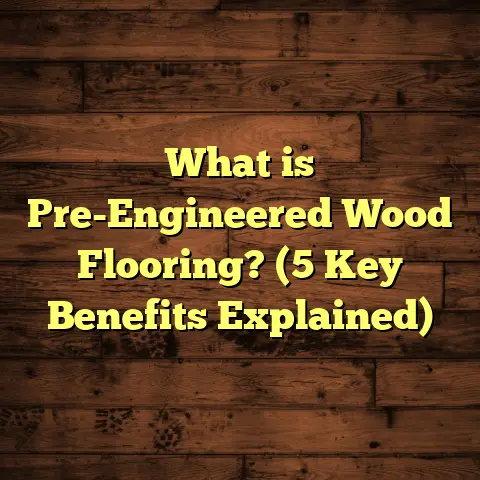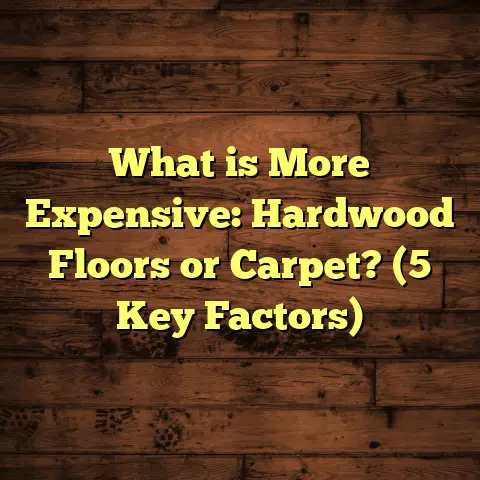What is Floor Buckling? (5 Key Causes & Solutions Revealed!)
What is Floor Buckling?
Have you ever walked into a room and noticed the floor looks like it’s got waves or hills? Like some parts are rising up, almost like a little bump under your feet? That’s floor buckling—a problem that can feel like a nightmare for homeowners. But what exactly is floor buckling?
Simply put, floor buckling happens when flooring material—usually wood, laminate, or vinyl—lifts up from its base and warps. This lifting creates an uneven surface that’s not only ugly but can also be dangerous and damaging over time. The floor literally “buckles” under pressure caused by expansion or moisture.
When I first started working as a flooring contractor, I thought floor buckling was just a rare fluke. But over the years, I’ve seen it crop up in all sorts of homes and buildings. It isn’t just about bad luck; it’s often a sign of deeper issues that need attention. This is why understanding what causes floor buckling and how to fix it can save you a lot of hassle—and money.
In this article, I’ll walk you through the five key causes of floor buckling based on real-world experience, backed by data and research. Plus, I’ll share solutions that can prevent or repair buckled floors effectively.
1. Excess Moisture: The Main Culprit
If there’s one cause at the heart of most floor buckling cases, it’s excess moisture. Moisture wreaks havoc on flooring materials because wood and similar products naturally expand when they absorb water.
Why Does Moisture Cause Buckling?
Wood is hygroscopic—meaning it absorbs moisture from the air or direct contact. When wood swells, it expands in size. If your floorboards are installed tightly without enough space to expand, the pressure builds up and causes the boards to buckle upwards.
I remember working on a home where a hidden plumbing leak under the kitchen floor went unnoticed for months. The result? The hardwood floor near the sink started to lift dramatically. The homeowner thought it was just cosmetic until I pulled up a board and found soaked plywood underneath.
How Big of an Issue Is This?
According to the Hardwood Flooring Manufacturers Association (HFMA), hardwood can expand as much as 8-12% in width with just a 10% rise in moisture content. Imagine planks that are 6 inches wide swelling by nearly half an inch—and then being trapped in place. That puts enormous internal stress on the floor system.
In fact, moisture-related issues account for nearly 70% of hardwood floor failures reported by professionals in various studies. Mold growth and rot often follow buckling problems if left untreated.
Common Sources of Moisture
- Leaks: Plumbing leaks beneath floors or inside walls.
- Spills: Repeated water spills from pets, kids, or kitchen activities.
- Humidity: High indoor humidity, especially in basements or bathrooms.
- Concrete slabs: Floors installed directly over concrete without vapor barriers.
How I Handle Moisture Problems
In my early days, I would sometimes install floors without insisting on proper moisture checks. That led to callbacks and unhappy clients. Now, moisture testing is always step one:
- I use moisture meters to check subfloor conditions.
- If moisture levels are high, I recommend vapor barriers or proper sealing before installation.
- I educate clients on maintaining indoor humidity between 30%-50%, especially during humid summers or winters with indoor heating.
Preventive Measures
- Acclimate flooring properly: Let wood sit in the installation room for several days so it adjusts to local humidity.
- Install vapor barriers: These are essential on concrete slabs or below-grade floors.
- Fix leaks immediately: Any plumbing or roof leaks must be addressed quickly.
- Maintain HVAC: Air conditioning or dehumidifiers help reduce indoor moisture buildup.
2. Improper Installation: The Hidden Danger
Even the best materials fail if installed incorrectly. One of the biggest mistakes I see is flooring installed without appropriate expansion gaps.
Why Do Expansion Gaps Matter?
Wood and laminate floors need to move. When humidity rises or temperatures fluctuate, flooring expands. If there’s no room to expand, the boards push against walls or each other and buckle.
Think about a metal bridge that expands on hot days—you’ll see gaps or joints designed to move with temperature changes. Flooring works the same way.
My Personal Experience with Bad Installation
Years ago, I was called in to fix laminate floors in a newly built home. The installers had skipped leaving expansion gaps around the edges to save time. Within weeks, the floor lifted along one wall like a wave.
Installation Best Practices
- Always leave an expansion gap of about 1/4 inch around all room edges.
- Use spacers during installation to maintain consistent gaps.
- Follow manufacturer guidelines exactly—they know their product’s limits.
- Ensure the subfloor is level and clean before laying flooring.
- Don’t install floors tightly against fixed objects like cabinets or walls without gaps.
What Happens Without Expansion Gaps?
Without these gaps, your floor becomes like a compressed spring waiting to explode upwards. This can cause not just buckling but also cracked boards, broken locking systems on laminate floors, and permanent damage.
3. Subfloor Issues: The Foundation Matters
The subfloor is the base layer beneath your finish flooring—usually plywood or concrete—and its condition hugely impacts your finish floor’s stability.
How Subfloor Problems Lead to Buckling
If your subfloor is wet, uneven, or damaged, it can push your finish floor upwards or create weak points where boards separate and lift.
For example:
- Plywood that has absorbed water swells unevenly.
- Concrete slabs with high moisture vapor emission rates can allow water to seep upwards.
- Uneven subfloors create pressure points causing planks to lift under stress.
Research Data
A survey by the National Wood Flooring Association (NWFA) found that about 60% of floor buckling issues trace back to subfloor moisture or damage.
My Approach to Subfloor Inspection
Before installing any floor, I check:
- Moisture content with specialized meters.
- Flatness using straight edges or laser levels.
- Structural integrity—looking for rot, mold, or weak spots.
If necessary, I recommend:
- Repairing or replacing damaged plywood.
- Installing moisture barriers or sealers on concrete slabs.
- Leveling uneven areas with patching compounds before laying flooring.
Subfloor Material Considerations
Plywood is common but not perfect; particleboard is cheaper but less durable under moisture stress. Concrete slabs require vapor barriers and sometimes moisture mitigation systems if humidity is high.
4. Temperature Fluctuations: The Silent Stressor
Temperature swings may seem harmless but they affect wood floors more than many people realize.
Why Temperature Changes Matter for Floors
Wood expands when heated and contracts when cooled. Over months and years, this cycle causes movement at joints and seams. If your floor isn’t installed to accommodate these movements—like through proper expansion gaps—the stress builds and leads to buckling.
Real-Life Examples from My Work
Older homes without central heating often show more buckling during summer months when heat peaks. Rooms with large south-facing windows get hotter and cause localized expansion.
I once worked on a sunroom where hardwood planks near windows were badly cupped due to intense sunlight heating during the day and cooler nights causing contraction at night.
Tips to Reduce Temperature Impact
- Use curtains or blinds to reduce direct sun exposure.
- Maintain stable indoor temperatures year-round with HVAC systems.
- Use engineered wood flooring in rooms exposed to temperature swings—it’s more stable than solid hardwood.
Flooring Options for Temperature-Stressed Areas
Engineered hardwood and luxury vinyl planks are designed with multiple layers to resist expansion/contraction better than solid wood.
5. Poor Quality Materials: Cutting Corners Costs More
Sometimes homeowners pick flooring materials based on price alone without realizing long-term risks.
Why Material Quality Affects Buckling
Low-quality wood or laminate lacks dimensional stability—it swells more with moisture and temperature changes. Cheap adhesives may fail under stress, allowing planks to lift easier.
I’ve seen laminate planks from discount stores buckle within weeks because their locking mechanisms were flimsy and couldn’t handle natural movement.
My Advice for Choosing Flooring
Invest in trusted brands with solid warranties. Look for:
- Good dimensional stability ratings.
- High-quality locking systems for laminate or engineered wood.
- Moisture-resistant finishes.
Don’t buy flooring designed only for dry climates if you live somewhere humid—quality matters for durability.
How Floor Buckling Affects Your Home Beyond Looks
Buckled floors aren’t just ugly; they impact your home’s safety and value:
- Trip hazards: Uneven surfaces can cause falls.
- Structural damage: Persistent buckling stresses subfloors and joists over time.
- Reduced property value: Potential buyers notice damaged floors immediately.
A client told me once how they avoided selling their house for months because their buckled hardwood was a massive eyesore on listing photos—the repair cost was an investment that paid off later.
What Can You Do Now? A Step-by-Step Guide
If you suspect your floors are starting to buckle:
- Inspect for moisture: Check basement humidity, leaks, plumbing.
- Look for gaps: Are expansion gaps missing around edges?
- Check subfloor condition: Especially if your floor is old or recently flooded.
- Assess temperature control: Are there major swings indoors?
- Evaluate flooring quality: Was it installed professionally? Are materials reputable?
If you find issues beyond your skill level, call a professional immediately. Quick action prevents costly repairs later.
Case Study: Fixing a Buckled Floor After Flood Damage
A family suffered a basement flood after heavy rains soaked their home’s foundation. They called me when their engineered hardwood started lifting across half their living room.
After moisture tests showed high levels beneath the floor and damaged plywood subflooring, we removed all affected planks and replaced the subfloor with water-resistant plywood plus a vapor barrier over the concrete slab.
We then reinstalled high-quality engineered hardwood with proper expansion gaps and acclimated the wood carefully before installation.
Today, their floors remain stable even after another rainy season—proof that addressing root causes works long term.
The Role of Maintenance in Preventing Buckling
Maintenance plays a huge role in keeping floors stable:
- Regularly check for water leaks under sinks and appliances.
- Clean spills promptly—don’t let water sit on floors.
- Use humidifiers or dehumidifiers seasonally depending on weather.
- Inspect floors annually for signs of lifting or cupping.
Summary Table: Causes & Solutions of Floor Buckling
| Cause | Signs to Look For | Solutions |
|---|---|---|
| Excess Moisture | Warping near wet areas, stains | Fix leaks, vapor barriers, humidity control |
| Improper Installation | No expansion gaps, tight edges | Leave gaps, follow installation guides |
| Subfloor Issues | Uneven floor surface | Repair subfloor, moisture testing |
| Temperature Changes | Seasonal warping | Stable temp control, engineered floors |
| Poor Quality Materials | Early warping post-installation | Choose quality products |
Final Thoughts: Your Floors Deserve Care
Floor buckling is frustrating but mostly preventable with knowledge and care. From controlling moisture to hiring skilled installers and choosing quality materials—you have control over your floor’s fate.
If you’re ever unsure about your floors’ health or want advice tailored to your home’s needs, just ask me anytime. After all, floors carry us through life—let’s keep them safe and beautiful together!





